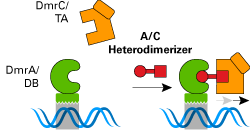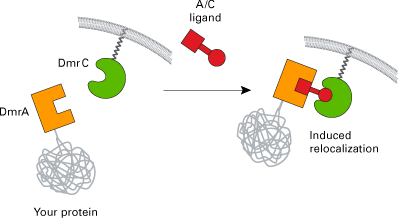Inducible Protein-Protein Interactions—iDimerize Systems
All essential processes of the cell are regulated by a complex network of protein-protein interactions. iDimerize technology allows you to induce the interaction between two proteins, or the re-localization of a protein, and thereby control any cellular process that is activated (or inactivated) by these events.
- Induce your protein to interact with another protein
- Direct the cellular localization of your protein
- Induction is extremely fast and specific
| Over 400 published applications using iDimerize technology | |||
| Signal transduction | Protein relocalization | Enzyme activation | Protein splicing |
| Inducible Apoptosis | Protein secretion | RNA splicing | Cell adhesion & rolling |
| Inducible transcription | Membrane lipid content | RNA splicing | Glycosylation |
| Ion Channel Gating | Membrane dynamics | DNA looping | |
How does iDimerize work?
To create an inducible system for protein-protein interactions, tag your protein(s) of interest with a dimerization domain (Dmr A, B, or C). Proteins fused to a Dmr domain can then be induced to interact by adding a small molecule ligand to the culture media (Fig. 1). The dimerizer ligands are designed to bind two Dmr domains with high affinity and specificity. When two Dmr-fused proteins happen to interact, the presence of dimerizer ligand traps and stabilizes the bound complex. Dmr domains and ligands vary depending on the iDimerize system used.

Figure 1. Inducing protein-protein interactions using the Inducible Homodimerization System.
iDimerize systems and ligands
Our tool box of Dmr domains and ligands allow inducible homodimerization, heterodimerization, reversible dimerization, and transcription activation. The possibilities are endless so with some imagination you can design an inducible dimerization system for your in vitro or in vivo application.
| Components and applications of available iDimerize systems |

Induce self-association of two copies of the same protein
Inducible Homodimerization System
Control a wide variety of cellular processes, including proliferation, differentiation, adhesion, transformation, and apoptosis.

Induce association of two different proteins
Inducible Heterodimerization System
Control cellular localization, conditional alleles of receptors, signaling molecules, and other proteins involved in a signaling pathway.

Induce dissociation (solubilization or deaggregation) of proteins
Inducible Reverse Dimerization System
Control the secretion and/or cellular location of proteins.

Induce transcription of a gene of interest
Regulated Transcription System
The Heterodimerization System motifs, fused to a transcription activation domain (TA) and a DNA binding domain (DB) respectively.
Technology is fast and highly specific
iDimerize technology can induce protein-protein interactions at speeds relevant to biological processes. In one recent study, heterodimerization was observed within 30 seconds of adding the small molecule dimerizer.
Since the induced interactions are limited to Dmr-fused protein(s), your experimental phenotype will not be compromised by off target effects. This level of control has made iDimerize systems the ideal choice for dissecting cell signaling pathways, where native ligands may activate multiple pathways.
Direct your protein anywhere in the cell
The Inducible Heterodimerization System has also been widely used to direct proteins to different locations within the cell (Fig. 2). Here, a DmrC domain is anchored at the desired subcellular location using the appropriate signal sequence. When the dimerizer ligand is added to media, any protein fused to a DmrA domain will localize to that location.

Figure 2. Inducing protein accumulation at the plasma membrane using the Inducible Heterodimerization System.











